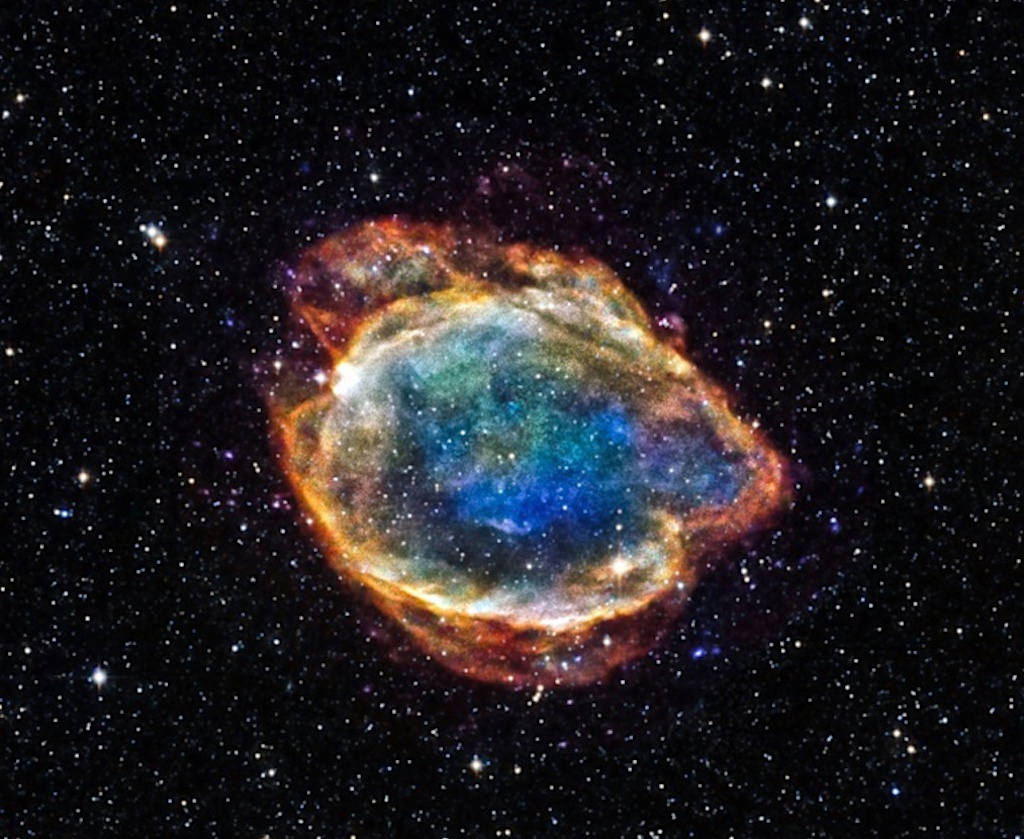Science
Astrophysicists Uncover Unique Supernova, Offering Insight into Stellar Death

Astrophysicists have made a significant discovery with the identification of a supernova named SN2021yfj, embedded in a wind rich with silicon, sulfur, and argon. This unique chemical signature suggests that the massive star responsible for this explosion lost its outer layers of hydrogen and helium long before it detonated, providing valuable insight into the inner workings of dying stars.
The observations indicate that SN2021yfj possesses a layered structure akin to that of an onion, consistent with long-held theories about massive stars. Typically, when these stars explode, scientists observe strong signatures of light elements such as hydrogen and helium. However, this supernova displayed a markedly different profile, revealing deeper layers of heavier elements.
Revealing the Structure of Massive Stars
The findings imply that the massive progenitor star ejected its outer hydrogen, helium, and carbon layers, exposing its inner layers rich in silicon and sulfur before the explosive event. This discovery sheds light on the theorized inner layered structure of massive stars, offering an unprecedented glimpse into a star’s interior just moments before its catastrophic end.
Massive stars, ranging from 10 to 100 times the mass of our Sun, are powered by nuclear fusion. This process involves intense pressure and extreme heat in the star’s core, causing lighter elements to fuse and form heavier ones. Over time, as stars evolve, they burn progressively heavier elements in their cores while lighter elements are consumed in surrounding shells. This cycle continues until the core becomes predominantly iron, leading to a collapse that triggers a supernova or the formation of a black hole.
The supernova SN2021yfj has surprised researchers by ejecting an unprecedented amount of material compared to previous observations of similar phenomena. While other “stripped stars” have shown layers of helium or carbon after shedding their hydrogen envelopes, SN2021yfj has exposed deeper layers, hinting at extraordinary processes occurring within.
Advanced Observations and Future Research
The discovery was facilitated by instruments at the Zwicky Transient Facility (ZTF), located just east of San Diego. ZTF utilizes a wide-field camera to scan the entire visible night sky, serving as a leading discovery engine for astronomical transients like supernovae. Through this investigation, the research team identified a star-forming region located 2.2 billion light-years from Earth.
To further understand the nature of SN2021yfj, the team aimed to obtain its spectrum, which breaks down light into its component colors. Analyzing the spectrum revealed strong signals of silicon, sulfur, and argon, rather than the typical helium, carbon, nitrogen, and oxygen found in other stripped supernovae. These heavier elements are produced during the final stages of a massive star’s life through nuclear fusion.
While the exact cause of this phenomenon remains uncertain, researchers are exploring various scenarios including interactions with a potential companion star, a massive pre-supernova eruption, or unusually strong stellar winds. The study detailing these findings has been published in the journal Nature, under the title “Extremely stripped supernova reveals a silicon and sulfur formation site.”
This remarkable discovery not only enhances our understanding of supernovae but also provides a deeper insight into the life cycles of massive stars, paving the way for further research into the complexities of stellar evolution.
-

 Education3 months ago
Education3 months agoBrandon University’s Failed $5 Million Project Sparks Oversight Review
-

 Science4 months ago
Science4 months agoMicrosoft Confirms U.S. Law Overrules Canadian Data Sovereignty
-

 Lifestyle3 months ago
Lifestyle3 months agoWinnipeg Celebrates Culinary Creativity During Le Burger Week 2025
-

 Health4 months ago
Health4 months agoMontreal’s Groupe Marcelle Leads Canadian Cosmetic Industry Growth
-

 Science4 months ago
Science4 months agoTech Innovator Amandipp Singh Transforms Hiring for Disabled
-

 Technology4 months ago
Technology4 months agoDragon Ball: Sparking! Zero Launching on Switch and Switch 2 This November
-

 Education4 months ago
Education4 months agoRed River College Launches New Programs to Address Industry Needs
-

 Technology4 months ago
Technology4 months agoGoogle Pixel 10 Pro Fold Specs Unveiled Ahead of Launch
-

 Business3 months ago
Business3 months agoRocket Lab Reports Strong Q2 2025 Revenue Growth and Future Plans
-

 Technology2 months ago
Technology2 months agoDiscord Faces Serious Security Breach Affecting Millions
-

 Education4 months ago
Education4 months agoAlberta Teachers’ Strike: Potential Impacts on Students and Families
-

 Education3 months ago
Education3 months agoNew SĆIȺNEW̱ SṮEȽIṮḴEȽ Elementary Opens in Langford for 2025/2026 Year
-

 Science4 months ago
Science4 months agoChina’s Wukong Spacesuit Sets New Standard for AI in Space
-

 Business4 months ago
Business4 months agoBNA Brewing to Open New Bowling Alley in Downtown Penticton
-

 Business4 months ago
Business4 months agoNew Estimates Reveal ChatGPT-5 Energy Use Could Soar
-

 Technology4 months ago
Technology4 months agoWorld of Warcraft Players Buzz Over 19-Quest Bee Challenge
-

 Business4 months ago
Business4 months agoDawson City Residents Rally Around Buy Canadian Movement
-

 Technology4 months ago
Technology4 months agoFuture Entertainment Launches DDoD with Gameplay Trailer Showcase
-

 Technology2 months ago
Technology2 months agoHuawei MatePad 12X Redefines Tablet Experience for Professionals
-

 Top Stories3 months ago
Top Stories3 months agoBlue Jays Shift José Berríos to Bullpen Ahead of Playoffs
-

 Technology4 months ago
Technology4 months agoGlobal Launch of Ragnarok M: Classic Set for September 3, 2025
-

 Technology4 months ago
Technology4 months agoInnovative 140W GaN Travel Adapter Combines Power and Convenience
-

 Science4 months ago
Science4 months agoXi Labs Innovates with New AI Operating System Set for 2025 Launch
-

 Technology4 months ago
Technology4 months agoNew IDR01 Smart Ring Offers Advanced Sports Tracking for $169









